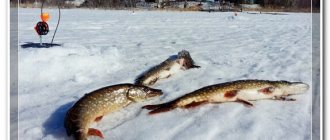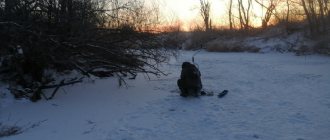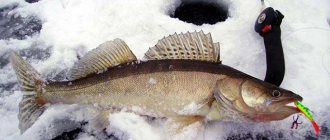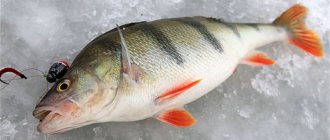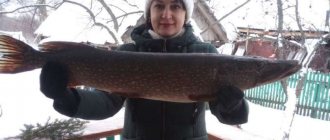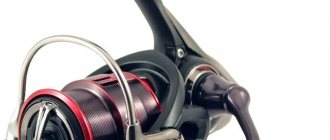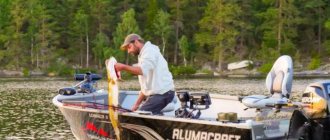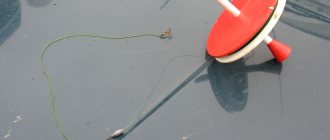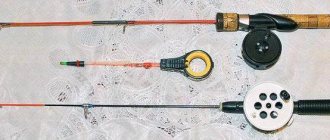The worst enemy of pike sport fishing is pike fishing with a set net. It must be said that uncontrolled pike fishing at stakes causes great damage to the reservoir, because stakers in some areas simply stand for weeks. Local residents go check them every day and of course there is no question of any sportiness. Of course, a huge amount of pike is killed, it happens that a large pike feeds once every two or three days, and sometimes once a week, and therefore, if the bettors have a pond under such pressure, then there is little pike in it.
Fishing for pike in winter on the first ice
If you use artificial bait from the ice, then you can have a catch on almost any winter day that is no less than that of the bettors, and this is very interesting, exciting, and most importantly, pike is a great fighter, during hooking, when you feel that great weight on a fishing rod, you feel with your hands how the fish is tearing, then it’s pleasantly interesting and exciting.
There are several periods in winter pike fishing from ice using artificial bait. Just like in perch fishing, there is a pronounced period of first ice, deep winter and last ice. Each period has its own characteristics. If we talk about the period of ice formation - the first ice period, then first of all you should catch pike in the coastal zone, where the ice is just beginning to form at the edges, where there are shallows, aquatic vegetation, reeds, where the depth is sometimes 20-30 cm under the ice there.
Such places are very easily recognized by their rates. When catching pike with artificial bait, you need to be quite creative, pay attention not only to finding places where the pike can stand, but also pay attention to other fishermen. First of all, these are the bettors - it’s like the angler’s competitors, but on the other hand, the bettors know exactly where in a given body of water you need to catch pike and if you want to catch a pike, then first of all you need to follow the bettors. If you don’t know the body of water and see that bettors are standing along the shore or along the riverbed, that’s where you need to move.
During the first ice, the pike clearly gravitates towards the shallows, where the ice is the thinnest and you should start fishing in such places. In the first ice conditions, pay attention to moving carefully on the ice. Despite the fact that pike actively feeds during the first ice, it can be caught well with artificial bait. On the first ice, if you do not act competently, not according to a certain scheme, you may be doomed to failure.
Factors influencing biting
Pike, like other underwater inhabitants, is dependent on the oxygen balance. At the end of winter, there is not enough air dissolved in the water, and the fish begin to move in search of sources of oxygen. Pike are more active in reservoirs with many springs gushing underwater. It often goes out onto the current - the old river bed present in reservoirs. Fish are also present near dam outlets, at the confluence of streams and small rivers.
Pike activity is affected by:
- Atmosphere pressure. Sharp fluctuations in barometer readings put pressure on underwater inhabitants, causing them to fall into stupor. Often this situation can be observed when fishing for perch, when a dancing jig in the center of a huge number of striped robbers does not arouse their interest at all. At low pressure the fish bite a little better than at high pressure.
- Weather, wind direction and strength. Spring is characterized by strong gusts of air masses. Pike prefers moderate winds from the south or west.
- Times of Day. In the morning, the predator bites best, but this factor may differ depending on the characteristics of the reservoir. Some water areas “turn on” the bite by noon and it lasts no more than an hour.
- Water transparency. At the end of winter, the water becomes cloudy and this affects the fish. Underwater inhabitants are endowed with many senses that allow them to find prey without the aid of vision. The pike feels the bait along the side line, so the turbidity of the water area is not an indicator of a bad bite.
- The power of the current. Large reservoirs with dams depend on the width of the drainage opening. When the dam opens, a current appears that mixes the water masses and replenishes them with oxygen.
Read: Winter perch fishing: a combination of bait fishing and trolling
At night, the toothy beauty rarely takes bait, however, when going to a reservoir for the night, it makes sense to leave the gear on the ice.
Angler camouflage when fishing for pike in winter
Camouflage is that when moving on transparent ice, to disguise your presence, it is better to look for heterogeneous spots, somewhere the ice is transparent, somewhere dark, matte, in some places snow has fallen, you should pay attention to these places. When the ice is transparent, and at the moment the air temperature on the reservoir is below zero, then you should definitely use this technique: we drilled a hole, a little water inevitably pours onto the ice, then we need to wait for some time so that this water freezes, as soon as it freezes, the ice in this place becomes matte - this is an excellent darkening, an excellent means of camouflaging anglers from the watchful gaze of pike. When fishing for pike in shallow water, it is imperative to take into account such a factor as the sensitivity of the pike to sound, because the pike can hear vibration well, any shaking of the ice. When the fisherman and often the bettors move, when their bet works, but the reel does not rotate, i.e. The pike stands still and as soon as the fisherman begins to run up, the pike hears this and begins to run away.
This happens not just on the first ice, when the ice is transparent and the fish can see it, but even on thick ice in the middle of winter. Pike reacts very well to vibrations; when fishing from ice, you need to move it very carefully. We also need to pay attention to how we drill the hole. A hole can be drilled at a certain distance, you can pump the hole, you don’t have to pump it, certain rules exist and these rules are as follows: if we are drilling a hole, then it is better not to pump it, so as not to expose the hole to light or create a lot of noise. When fishing for pike, when we remove too much ice from the hole, this is very bad, because a lot of light comes in, the bait plays in this cone, and this can negatively affect the result. Although there are days when pike are better caught in illuminated holes, because... the bait begins to play in the beam of light, gives more glare and the fish reacts better.
Which live bait to choose
The universal pike bait for most reservoirs is roach or perch. They are playful and move a lot. Usually schooling roach and perch are well caught using a jig with bloodworms. If you caught live bait right before setting the poles, then it will run better on the rig than live bait brought in the eland.
Ruff, gudgeon, and bleak can also be good live bait. The good thing about gudgeon and ruffe is that, being above the bottom, they always try to go down and with their vibrations attract pike from afar. The bleak is also very mobile. Sometimes, to catch large pike, anglers bait bait with bream.
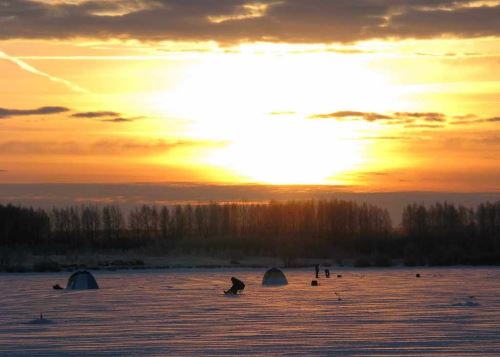
Small crucian carp are often on sale. It is very tenacious, but pike do not always like it. I usually take a dozen crucian carp with me and bait the bait with them so as not to waste time fishing with a jig, because in the spring the pike starts fishing early in the morning. After installing the girders, I begin to catch perches and roaches somewhere nearby using a jig, and gradually replace live bait, releasing crucian carp into the pond.
In general, it is better to release any live bait remaining on the hook into the reservoir, and not leave it to be eaten by crows. In order for the live bait to remain mobile for a long time, you need to select tees made of thin wire and make a delicate puncture behind the dorsal fin with a hook.
Features of drilling holes in winter for pike fishing
What is the best way to drill holes? The first step is to come to the pond and drill a hole, while counting the number of revolutions of the drill. Then we will drill the next hole two turns less, pull out the okroshka, then drill it further and then you don’t have to pump the hole, a small amount of okrosh remains in it, the bait will easily fall through there, and the hole will be darkened from light. After we have drilled a hole, it cannot be pumped with a drill, i.e. You can’t pull sharply down and up, so as not to make noise, but carefully get the drill, but since we already took out the okroshka in advance and there is enough of it left to darken the hole, so that the bait goes through without problems and the pike will be caught.
In our opinion, it is best to drill about 8-10 holes in one pass. While the ice is transparent, we can figure out where it is best to drill holes. After we drilled the 10th hole, we return quietly back along a different road so as not to spook the pike. The tactics for catching pike on the first ice are as follows: we made 8-10 holes, quietly go around from the side, approach the first hole, carefully lower the bait into the hole and start trolling. 8 - 10 strokes are enough, if there is no bite, no need to linger, move on to the next hole, also do 10 strokes, etc., We reached the last hole, take the drill and drill 10 holes again, on the way further and now, Also, the most important thing is to start fishing from the first hole.
Already in the second pass we fish 20 holes, go to the end, drill another 10 holes, again return to the first hole, etc.
We go through up to 100-150 holes a day. This tactic always brings results, by acting in this way we catch both the most active and the most passive fish, which moved to the side, got scared by our noise, returned back, we approach and offer it a spoon on a silver platter. When we drill about a hundred holes in a day, we dip our baits into each hole at least ten times - it is advisable to take a new bait for each pass.
We fished ten holes with one bait, drilled another ten holes, returned to the first hole and made a passage of 20 holes with another bait, drilled a third row of holes, made a passage with a third type of bait. We constantly rotate baits, so every time in the same hole we use different baits, pike baits with different properties. The likelihood that a pike will grab one of them is very high.
It must be said that this technique of passing holes works not only on the first ice, but also in the dead of winter and on the last ice. You should always make it a rule - all the holes that you drill must be constantly checked that day, because any pikeper drills holes not just anywhere, but in the most promising places.
Pike fishing in the middle of nowhere
In the dead of winter it is more difficult to find pike. Many anglers limit themselves to fishing for pike only on the first ice. This is not correct, because the strategy needs to be changed a little. If during the first ice at shallow depths we can meet deep, good, thick pike, then when the dead of winter sets in, pike from shallow water begin to move to depth.
We need to act as follows: as soon as the first ice is gone, we practically don’t pay attention to shallow water, but look for pike on the deep edges. To find deep edges, you can focus on pike fish, who fish with stakes, or follow the bottom topography. You need to drill a lot of holes, thereby looking for slopes, looking for all kinds of flooded snags, areas with all kinds of anomalies at the bottom, and fish very carefully in such places.
When searching for pike on deep edges, you should act in this way, i.e. we drill holes at a distance of about 10 meters until we find a depth difference; once we have found it, the distance can be reduced to 5 meters and it is advisable to fish the holes very carefully, and follow the depth difference along the length of the fishing line. In our opinion, it is best to catch pike either on the upper part of the edge or on the very bottom; these are the places you definitely need to pay attention to. In order not to miss them, you need to drill often.
Particular attention should be paid to snags; if we find an underwater snag, it should be drilled from all sides in order to find a more optimal place. It is advisable that the bait be fed as close to the snag as possible, but at the same time not cling to it. Accordingly, when fishing for pike, especially in snaggy places, it is necessary to have a heavy hook with you to hit our bait. Without unhooking, the consumption of bait will be very high.
You should definitely make it a rule to change baits, but if when fishing on the first ice we can use any pike bait for fishing from ice, then when fishing at depth we should use heavy, compact baits - large balancers, heavy oscillating spoons. These two types of lures work very well in deep water. They sink quickly and you can fish with them very quickly. If we use a light oscillator at a depth of 5-6 meters, which shows excellent results on the first ice at shallow depths, then due to the fact that it sinks very slowly to the bottom, we lose time, but the more holes we drill in a day, the higher the likelihood that we will stumble upon a pike. About 5-6 pike bites per day are considered the norm; this is on the least biting day; on a good bite, the number of bites can reach 15-20 per fishing trip.
In the blue-winter region, you should pay attention to all kinds of fontanelles and channels and streams flowing into the reservoir. All such places attract the attention of small fish, and after them the pike comes. Pike always stays near such places, because... It's warmer there. Any fontanel has a temperature much higher than the temperature under the ice. In the area of fontanelles and the mouths of tributaries, fish find better conditions for hunting and feeding.
Fishing tactics
How to catch pike in March? The predator at this time is not picky about bait. It just may not be in a given place. There may be several reasons why pike do not bite in March:
- The predator went upstream
- She is currently resting. Therefore, if it is reliably known that a toothy one is here, it’s worth waiting, it will show itself. Maybe she comes out to feed at a certain time.
- The bait is too large or the artificial bait is not performing as expected. In the spring you need to use small baitfish and constantly experiment with spoons, balancers or rattlins.
- The influence of the phases of the moon or weather on the pike bite.
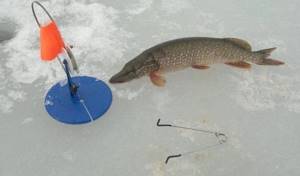
Favorable days for pike fishing in March are periods of constant calm weather. But this is in theory. In practice, it is impossible to predict the toothy bite. You don’t need to read the theory, but go out onto the pond and experiment with the location or gear. The main thing in spring ice fishing for toothy fish is active search. The more places checked, the higher the chances of catching her.
Fishing tactics directly depend on the location, conditions and body of water. Holes are drilled along the wall of reeds, respectively, along the thickets. Shallow bays are tested using the square-cluster or snake method. When fishing in reservoirs without any significant relief anomalies, you need to find out the distance from the shore (depth) where the predator stands. Accordingly, when determining any trends, further fishing occurs according to the already identified features.
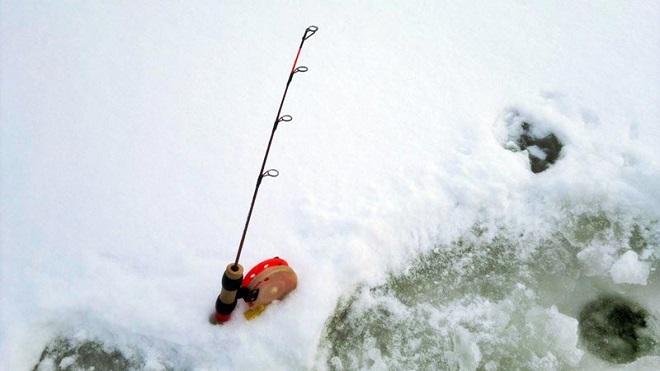
Zherlitsy
The most common method for pike fish at this time is winter fishing for pike in March with girders. Over the years, avid garrisons have known where and at what time the toothed one is present in the spring. There they place supplies on the predator. A beginner should focus on them. Grandfathers usually sit on the ice for a reason. No special equipment is required - a leash, a hook and a sliding olive. If there is a toothy one, sooner or later it will take live bait. The main thing is to choose the right fish and installation location. An article about fishing with girders in March.

Pike fishing on the last ice
On the last ice, pike should be caught in those places where streams flow into, where snow begins to melt and small melt waters enter the reservoir. The fry gather in such places and naturally the pike comes there. At the end of winter, it is very interesting to catch pike; under the last ice, it literally becomes hungry, because it is preparing for spawning. Its spawning occurs quite early, when the ice has not yet left the reservoir and, in principle, during the last ice, pike fishing with artificial bait is the most active for the entire winter period. On the last ice there is a danger of falling through the ice, so you need to be very careful. Pike along the last ice approaches channels, to those places where the ice is already heterogeneous and weak, where it can be caught very effectively, but also dangerously. It should be noted that in some places there has been a ban on pike since March 1, so if you are catching pike with artificial baits, pay attention to the presence of rates on the reservoir; if there are none, and you go with a spoon and try to catch pike, then you You can run into trouble when the reservoir is under the watchful supervision of the fishery inspectorate.
☸ Fishing for perch
Gaining strength before spawning, the striped predator exhibits sustained activity. His appetite is increased by fresh water seeping under the ice, saturated with life-giving oxygen. True, even during this favorable period, not all fishermen manage to catch it. To do this, you need to have some experience and know the location of the fishing object.
In spring, sailors move to shallow water, closer to dry reeds and other remnants of last year's vegetation. Most often, it is possible to catch 2-3 individuals from a hole, then you have to move a couple of meters, chasing the flock. It happens that a schooling perch stands in one place and is in no hurry. In this case, the point gives a crazy bite and a rich catch.
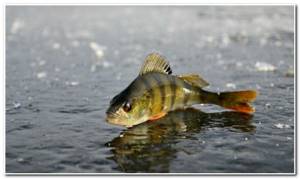
Striped fish are caught using jigs, winter lures or balancers, and the appropriate gear is selected for each of these baits. For the last ice, it makes sense to use a thicker fishing line, for example, with a diameter of 0.16 or 0.18 mm. Some believe that monofilament of such thickness scares away fish, and then bite their elbows after losing a trophy specimen. Especially in early spring, when perches weighing up to one and a half kilograms often sit on the hook.
It must be said that the location of the predator is influenced by weather factors, so it cannot always be found in its usual areas. Perch does not like bright light; on a sunny day it hides under snow-covered ice or in the shade of trees growing on the shore. When atmospheric pressure decreases, both humpback whales and small perches move from shallows to depth. If it jumps up and down, the bite becomes sluggish or stops completely.
Lures for catching pike in winter
Pike lures for fishing on the first ice are almost all spinning lures that you use to catch pike in the summer. It could even be silicone baits, but they didn’t take root very well with us; the results were, but much worse than when fishing with conventional oscillating spoons or balancers.
When fishing for pike on the first ice, light, oscillating spoons show excellent results. They can be used to catch pike during the open water season using a spinning rod; they also show excellent results when fishing from ice.
On the first ice, fishing is carried out at shallow depths and light sailing baits sink very slowly in the water, sinking very beautifully, swaying seductively from side to side. Many fishermen use homemade baits for catching pike from ice, with a single soldered hook, sawed out, ground out, etc. The disadvantages of these baits are that each bait has a different game and you need to adapt to each bait, but if we use branded baits, we don’t have such problems.
If, when fishing with oscillating spoons, we have lost the number of slips, we can put an additional tee on the top ring of the spinner, thereby reducing the number of slips. Another technique for lure fishing is to place the lure on the bottom. We lay the spoon, give the bait from the fishing line, then make a jerk and again put the spoon on the bottom, etc. When fishing from the bottom, it is advisable to jerk a little higher and give a full slack after the spoon falls to the bottom.
The pike grabs the spoon exactly at the moment when it falls to the bottom; from the bottom it no longer touches it. Lightweight spinners are good because they fall more slowly during this kind of play. There are days when pike can be caught exclusively from the bottom, i.e. After each stroke we place the spoon on the bottom, but the pike grabs it at the moment when the spoon sinks.
Rattlins for pike fishing
The next type of lure for catching pike in winter that we will tell you about is rattlin. Rattlins show excellent results in catching pike and have the advantage of two hooks. A very rare pike bite ends with impunity. The pike is caught very well. When fishing with a rattlin, it is important to know how to play this bait because it works very well. During the throw, the rattlin vibrates due to the frontal resistance, the balls rattle inside, attracting pike from a great distance and at the top, when we made a jerk, it is advisable not to immediately reset, as when fishing with a spinner, be sure to wait 4 seconds, then let it fly freely or controlled. You can lift the rattlin with several jerks, thereby making rhythmic jerks. The rattlin has a drawback - it does not work well at great depths (more than 3 meters); if it falls, it can go into a tailspin and get hooked on the fishing line. But there are deep rattlins, they are heavier and due to this, they also catch pike well at great depths.
Non-snagging lures for pike fishing in winter
It is very interesting to use non-snagging lures with wire whiskers and a rigid hook. Such spoons are good when fishing in snags; with such spoons we can fish in the most fishable snags, where no one dares to fish with a balancer or an oscillating spoon. Non-clinging spinners have only one drawback - they are very light, because... made of thin metal, so there is a limit on depth.
Ice wobbler for pike
This is practically the same rattlin, but it is balanced in such a way that when it rises up it makes oscillatory movements, and when it sinks it moves to the side, due to the fact that the weight is shifted to the front. This bait shows very good results, the only drawback is that many manufacturers do not make them in large sizes. You can fish at shallow depths of up to two meters.
When fishing for pike at great depths, deep edges, excellent results are shown by a triangular spinner, which is generally intended for catching asp and pike perch, but also performs well in winter.
Balancers for pike fishing in winter
You can fish with a balancer in winter both in shallow water and in deep water. Among winter pike lures, the balancer is one of the top three leaders. If we talk about the pike size of the balancer, then the most universal balancer for catching pike will be a balancer with a valley of more than 7 cm. The disadvantage of balancers is that they often have poor adjustment.
When fishing for pike, the more monotonous the bait plays, the better it is. It is also very important to choose the right bait color. For example, in a pond, pike feed on roach, it is advisable to select the color of the bait to match the roach, if under the perch, then under the perch, etc. The easiest way is to find out what pike eat from the bettors. What color of live bait works best for bettors, what size, what color - this is approximately the color we need to select our bait for vertical pike fishing.
Choosing a fishing spot
It has long been known that pike follow schools of forage fish at any time of the year. In the spring, when stable above-zero temperatures appear, dense schools of small perch, roach, silver bream and other fish move to the shore. Sometimes flocks of roaches and minke whales feed in the shallowest waters, where the depth does not exceed 50 cm.
Pike can also come to such places for an easy meal. Small pike are often caught where small forage fish are located. In extremely shallow water, it is more convenient for medium-sized pike to hunt forage fish, because the latter’s movements are largely limited by the lower edge of the ice and the bottom.
But in the spring, larger fish also enter narrow coastal niches, so in some bays of reservoirs it was possible to catch quite heavy pikes from a depth of only 20–40 cm using girders. So, one day, in a small bay of dammed Mologa, we came across a small roach near the shore.
Nearby, in extremely shallow water, I placed a dozen girders, as a result of which I saw five rises and took two pikes, one of which pulled 2.5 kg. Here it should be said right away that where the depth of fishing on the girder is 20–30 cm, the pike more often breaks the bait, especially if algae interferes with the movement of the fishing line when unwinding the girder.
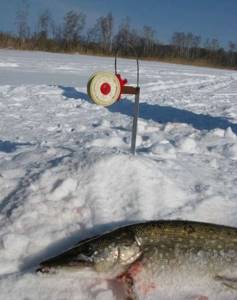
The largest pikes rarely feed on small things or do not feed on them at all (too much energy expenditure during hunting, and the protein intake is insignificant). But, of course, a lot here depends on the food supply of the reservoir. Thus, on many lakes in the Tver and Novgorod regions, large pike often follow schools of small bream, which, even in tributaries or narrow elongated bays, usually stick to the channel, rarely reaching shallows with clear water (sometimes it happens at the very end of freeze-up).
In this regard, at the end of the freeze-up, you should not focus only on extremely shallow water, but also choose deeper places. For example, in March on Lake Shlino in the Tver region there are a lot of pike in the upper reaches of the bay, where the main influx flows. At this time, schools of a wide variety of forage fish gather here: roach, bream, ide, dace, bleak, and silver bream.
The fish that survive in the watering are mostly small, and pike are more often found here weighing up to 1.5 kg. But on the edges, where the depth is 1–2 m and where a decent bream is biting, you can catch “toothy” and larger ones, which is due to the entry of schools of large bream along the riverbed (movement along the tributary is limited by a dam through which the passage pipe passes).
However, in the spring, a large number of fishermen can appear on the ice of shallow fishing bays, and pike, especially large ones, do not like noise. Therefore, at the beginning of the “white” fish’s run, you can end up with a “toothy” catch, but later you won’t even get away from zero.
When it gets colder, pike coming out to hunt in shallow waters can again move to depths of 5–6 m, or even more. In general, I noticed that on large lakes and reservoirs, even at the end of the freeze-up, some of the schools of large “white” fish remain on feeding underwater hills remote from the shore or in irrigation areas near a flooded riverbed, and large predators often feed here: pike, perch, burbot. Therefore, if the pike does not take near the shore, and the ice is still strong, I sometimes go to check the deep waters known to me.
By the way, these water areas may not be so far from the coast. For example, at one time I often fished in the tributaries of the Vazuz Reservoir, usually placing vents along the watering holes and edges of the flooded tributary channel, often focusing on individual snags. Here, the depth of setting the girders was 0.2–1.5 m and medium-sized pike were caught predictably.
But in that place the reservoir is quite narrow, and from the area where shallow water vents were placed to the edge of the main channel there was no more than 200–300 m, so I placed some of the vents at depth. And although at depth the bites were much less frequent, there were specimens there that were much larger than the mass of those caught in the shallows; At the same time, there was also a pike perch on the edge. By the way, pike and pike perch bites on the edges often occurred in the dark.
When searching for pike exit points in the spring, you should also focus on other areas:
- slopes of coastal and island sandy-rocky spits;
- edge of algae (cattail, arrowhead, pondweed) - around the islands and near the shore;
- long or short stretches of reeds;
- ditches near the shore (running along it or perpendicular to it);
- shallow channels between the shore and the islands;
- coastal dumps.
In such areas, the vents are installed at different depths.
Tackle for catching pike from ice using artificial bait
Fishing rod
It's best to have it tough. We don’t need a nod for fishing with balance beams, because the balance beam is a heavy bait, but if we are going to fish on the first ice, on the last, with small light baits that float and slowly sink, then we need a nod. It allows you to track the play of the spinner well and control the bottom well.
Line thickness
The fishing line can have a diameter of at least 0.25 mm, preferably 0.28 - 0.3, in some cases up to 0.35 mm. In our opinion, mono line is best suited, because the pike resists very actively and with a long mono line it is good to tire it. With a mono line, fishing for pike is much more convenient and enjoyable, and when we bring the fish to the hole with a mono line, there are much fewer fishtails.
Leash
This can be a thin braided cable with a diameter of 0.18 mm, at the bottom of the fastener, and the leading material itself is different in that it can be tied in knots and it holds the load very well.
When fishing for pike, it is always advisable to use a leash. They can be of different types, soft - most suitable for catching pike with artificial baits; you can even use leashes made from a regular guitar string No. 2, i.e. Our leash is rigid and this does not affect the number of bites. The advantage of a rigid leash is that it prevents tangles.
Catching pike from the ice with artificial bait is very exciting and in terms of effectiveness it is almost no worse than fishing with girders, but in terms of excitement it is very interesting and the size of the trophies is very pleasing. It’s one thing to hunt for perch and the chance that you’ll catch a big one is not high, but when hunting for pike there’s always the opportunity to catch a very large pike and fight to catch it. Fishing for pike in winter is not as difficult as many people think, the baits are the same - almost everything can be used in summer, but it is very important to check their game and be sure that it plays well when they are offered vertically to the fish.
Installation of tackle and equipment
The last ice can be loose, and the girders on it are unstable, so I use girders with a wide plastic base. They fold compactly into the bag designed for them. The tip of the signal plate of the flag must be bent so that twitching of the live bait does not lead to idle bites, but at the same time there should not be strong resistance to the plate, since in the spring the pike is very sensitive.

For fishing at depths from 1 to 6 m, I use conventional equipment with a “Cheburashka” sinker weighing 10–20 g, which, depending on the size of the baitfish, will allow it to move in wide circles to better attract a predator. In this regard, you should approach the holes every half hour and, without disturbing the tension of the flag plate, pull the fishing line (the holes should be covered with snow). If the pike takes very sluggishly and often throws live bait, then the weight of the sinker needs to be extremely reduced (sometimes it is enough to pin a few pellets on a soft fishing line so that they allow the bait to go to depth).
When fishing on marginal shallows, it is better to use equipment without a sinker, since here, due to the limited space, it will interfere with the movements of live bait. A rig without a sinker allows the fish to swim freely, either rising under the edge of the ice or sinking to the bottom. Without a sinker, the rig has to be pushed under the ice with a wooden flyer.
In the spring, as already mentioned, the pike becomes very sensitive, so a metal leash will be superfluous. The tee is tied directly to the main line with a diameter of 0.38–0.4 mm. It is desirable that the line be soft and without memory, then it twists less in rings and is better stretched into a line under the weight of live bait or live bait and sinker.
In this case, to prevent the pike from biting off the leash, after the bite you need to give it the opportunity to unwind the line and stop, and when it moves again, hook it. After this, do not fish immediately, but pull back a couple of tens of centimeters of the fishing line so that it can go behind the so-called pike whisker - this will prevent the fishing line from getting on the sharp teeth of the predator.
In the spring, you also need to have at least a dozen under-ice fishing poles in your fishing arsenal. Their design is simple and does not take up much space in the fishing box. But these supplies help out during night fishing. At night in March there are still severe frosts, and since due to the lack of snow cover there is nothing to cover the holes with, the fishing line of ordinary fishing rods freezes to the ice; at the same time, the unwinding of the under-ice vents is carried out without hindrance.
